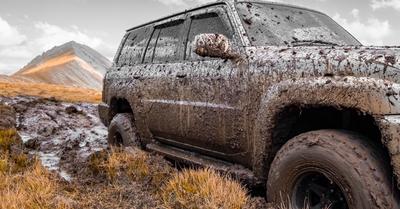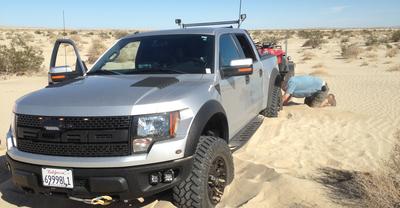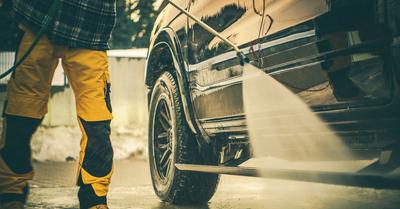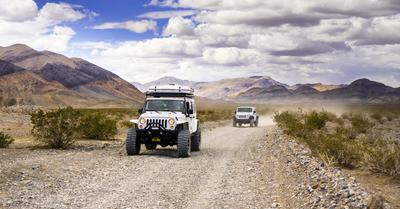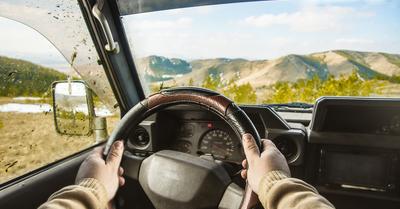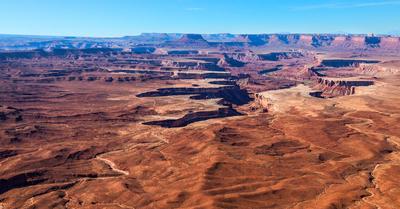Off-roading is surprisingly beginner-friendly once you get the hang of it, especially if you start off with the right tips and tricks.
All you need to go off-roading is the right vehicle (4WD trucks are a good option), a manageable trail that you or a trusted source has explored, and a tool kit with first aid supplies. It also helps to bring an experienced off-reader along in a separate vehicle.
In this article, we’ll go over several tips for beginners to choose the right off-road vehicle. We’ll also give some helpful off-road driving information that can help you avoid getting stuck in a rut. Also, we’ll cover a short list of must-have essentials in your off-road supply kit.
We sourced this information from the off-roading community and from our extensive experience exploring off-road trails.
This article may contain affiliate links where we earn a commission from qualifying purchases.
Is Off-Roading Safe for Beginners?
Many beginners are nervous, especially when driving off-road for the first time. But is there any reason to be? Generally speaking, no—off-roading can be completely safe for beginners, provided they drive carefully and take a few basic precautions.
Taking a beginner down a rock face in a remote area probably isn’t the safest idea. But many off-road trails are pretty easy and free from cliffs and major obstacles, making them ideal for beginners. Additionally, most people who are competent drivers get the hang of it very quickly.
How Can Beginners Get Started Off-Roading?
Sometimes, getting started can be challenging if you don’t really know much about off-roading. Where do you go? What kind of vehicle do you need? These are all fairly simple questions to answer, and it’s best to find a friend or a local to help you out.
Many off-road trails are accessible to the public, but they’re poorly mapped or not mapped at all. Trusted local off-roaders can give you an accurate impression of where to go and what to expect, along with practical tips and a helping hand.
A great place to begin researching is on off-roading forums. These sites usually have categories dedicated to vehicle selection, driving tips, and even local trail maps. Signing up to a forum (or two) is definitely a good idea when you’re first starting out. It also gives you a place to ask questions and get multiple answers.
Beginner Off-Roading Vehicle Selection Tips
What kind of vehicle is best for beginners to off-road in? It all depends on the kind of terrain you’re dealing with and what you’re used to driving. If you already have a truck, that’s a great place to start. SUVs also work well, provided they’re built on truck platforms. Here are a few more tips about choosing an off-road vehicle.
Cheap Trucks are OK
It’s totally fine to buy a beater truck for your off-roading, especially if you’re new. This way, it won’t matter much if you bash the fender or scrape the bottom a few times. Just make sure it runs right and the brakes work and double-check these things before embarking on a trail run.
Get Something With Four-Wheel-Drive
First of all, four-wheel-drive and all-wheel-drive are not the same things. Four-wheel-drive is used on trucks and SUVs, and it uses a transfer case that can be engaged in either four-wheel-drive high or four-wheel-drive low.
Four-wheel-drive is not designed to be used on pavement, but it is a superior system off-road. All-wheel-drive (AWD) is a dynamic system that’s designed for traction on pavement.
It’s best to purchase a four-wheel-drive vehicle for off-roading and to avoid all-wheel-drive vehicles (with the exception of Subaru vehicles). The vast majority of all-wheel-drive vehicles are not at all designed to drive off-road, and doing so can damage them.
Manual Transmissions Are Your Friend
This suggestion supplies primarily to people who already know how to drive a manual transmission. As you probably know, manual transmissions give you a lot more control over the vehicle, and specifically, engine braking. These traits can be very advantageous off-road, especially if you’re already good at driving a manual transmission.
Trucks Are A Great Starting Point
Pickup trucks are extremely popular off-road vehicles. This is because they’re inexpensive compared to SUVs and Jeeps, and they’re infinitely modifiable at a reasonable price point. Trucks are easy to work on, they have high ground clearance, and they’re usually tough enough to handle a mistake or two.
Is Diesel Better than Gas for Off-Roading?
The diesel versus gasser debate has raged for decades, and you won’t find a definitive solution here. Diesel vehicles are good for some environments, and gassers are good for others.
However, most diesel trucks sold in the United States are 3/4-ton or 1-ton vehicles, which have much stiffer suspension than half-ton gassers.
If you’re looking for a comfortable ride, you’re probably going to want a gas-powered half-ton. But if you’re looking to do serious crawling or off-road hauling, a diesel will serve you well for a very long time. It’s a matter of personal preference beyond that, and it’s a good idea to drive them both and see what you prefer.
Off-Road Driving Tips for Beginners
Finding the right vehicle is a great start, but it’s only half of the challenge. Driving off-road requires a level of skill that most people need some time to develop. That said, you can get a head start by following a few simple off-road driving tips.
Speed Sometimes Helps
Everybody’s off-road driving strategy is different, but this situation has happened to almost everyone. Picture the situation—you’re traveling along a fairly dry road when a mud patch appears with big tire ruts, indicating that it’s slippery and deep. If the mud hole isn’t too long, you can drive through it—but you might get stuck if you go too slow.
At some point, having a 4x4 makes very little difference in the mud. You’ll need mud tires to get through some mud holes, but you can plow through others as long as you have sufficient momentum.
Mud will slow you down significantly and might make you veer off course. If you don’t have any obstacles, you can speed up and keep the wheel straight. Stay on the throttle as you go through, and rev up as necessary if you slow down too soon. You’re just trying to get through the mud pit, so maneuver as necessary to get at least two of your power wheels on dry dirt.
Speed Can Also Be Your Enemy
Speed should generally be used sparingly off-road. In most situations, going slow is in your favor. It’s best to avoid going over about 30 on loose roads with tight turns. Gravel will cause your wheels to slip if you turn too hard, and braking distances are greatly increased. The same goes for packed dirt roads, especially when they’re wet.
What to Bring Off-Roading
It’s a great idea to bring a few extra items along with you, especially if you’re off-roading in a rural or remote area. Start with basic tools and parts, such as a tow strap, auto socket set, zip ties, hose clamps, vacuum hoses, fuses, pliers, and whatnot.
Additionally, always keep a fire extinguisher and a first aid kit in your vehicle. Fire can be a serious threat off-road, especially during the dry season. Catalytic converters can start grass fires just by touching them, so avoid parking over tall grass whenever possible.
Bring garbage bags to pick up your trash and perhaps some spare food and a blanket in case you decide to stay overnight. These items are also useful in an emergency if your truck or SUV breaks and you can’t make it home.


